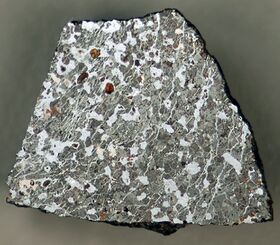Astronomy:Acapulcoite
| Acapulcoite | |
|---|---|
| — Group — | |
 NWA 2989, an example of an acapulcoite meteorite | |
| Type | Achondrite |
| Structural classification | ? |
| Class | Primitive achondrite |
| Subgroups |
|
| Parent body | Unknown |
| Composition | Olivine, orthopyroxene, plagioclase, meteoric iron, troilite |
| Total known specimens | Fifty two |
| Alternative names | Acapulcoites, Acapulcoite group, Acapulcoite meteorites |
Acapulcoites are a group of the primitive achondrite class of stony meteorites.
Naming and history
The acapulcoites are named after the only specimen of the group, with a witnessed fall. The Acapulca meteorite fell on 11 August 1976 at 11:00 near El Quemado Colony ( [ ⚑ ] 16°52′59″N 99°54′00″W / 16.883°N 99.9°W), outside Acapulco, Guerrero, Mexico. It had a mass of 1,914 grams (67.5 oz). The stone was retrieved 15 minutes afterwards from a 30 centimetres (12 in) deep crater and was cool to the touch.[1] Following that discovery, 52 meteorite specimens have been classified as acapulcoites.[2]
Chemical composition
Acapulcoites are primarily composed of olivine, orthopyroxene, plagioclase, meteoric iron, and troilite.
Like all primitive achondrites, acapulcoites have chemical composition and mineralogical similarities with chondrites,[3] some specimen even show relic chondrules. Their mineral composition lies between H and E chondrites.[3]
See also
References
- ↑ "Acapulco". Meteoritical Bulletin Database. http://www.lpi.usra.edu/meteor/metbull.php?sea=Acapulcoite&sfor=types&ants=&falls=&valids=&stype=exact&lrec=2000&map=ge&browse=&country=All&srt=name&categ=All&mblist=All&rect=&phot=no&snew=0&pnt=Normal%20table&code=10.
- ↑ "Meteoritical Bulletin Database". Meteoritical Bulletin. http://www.lpi.usra.edu/meteor/metbull.php?sea=Acapulcoite&sfor=types&stype=exact&lrec=2000&srt=name.
- ↑ 3.0 3.1 "PAC Group - Primitive Achondrites". Meteorite.fr. http://www.meteorite.fr/en/classification/PAC-group.htm.
 |

